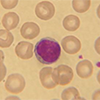Haptoglobin
Specimen Volume
1 ml whole bloodSample Preparation
Turnaround Time
24 hoursSample Processing In Laboratory
UsualSample Stability
Samples are stable for 3 months at 15℃, sample are stable for 8 months at 8℃
General Information
Haptoglobin binds free haemoglobin (Hb) resulting from pathologically elevated haemolysis with the Hp-Hb complexes stored in hepatocytes, and so prevents iron loss. For this reason, haptoglobin levels will be decreased in haemolytic anaemias. Causes of haemolysis include transfusion reactions, certain drugs, and/or mechanical breakage, such as may be seen with some artificial heart valves. The destruction may be mild or severe, acute or chronic.
Serum haptoglobin levels are often elevated following acute burns, acute and chronic inflammatory states and nephrotic syndrome, and is reduced in hyperlipidaemic states. Liver disease may also result in low haptoglobin levels as liver damage may reduce both the production of haptoglobin and the removal of the haptoglobin-haemoglobin complexes. The acute-phase response in inflammatory and malignant disorders is best determined by serial measurements of haptoglobin and other proteins.
Patient Preparation
None
Notes
There is no significant interference from icterus, haemolysis or lipaemia. In very rare cases gammopathy, in particular type IgM (Waldenström’s macroglobulinaemia), may cause unreliable results.
Reference Range
Males 0.14 - 2.58 g/L
Females 0.35 - 2.50 g/L
Specifications
-
EQA Status:
NEQAS
- EQAS Scheme: Yes








